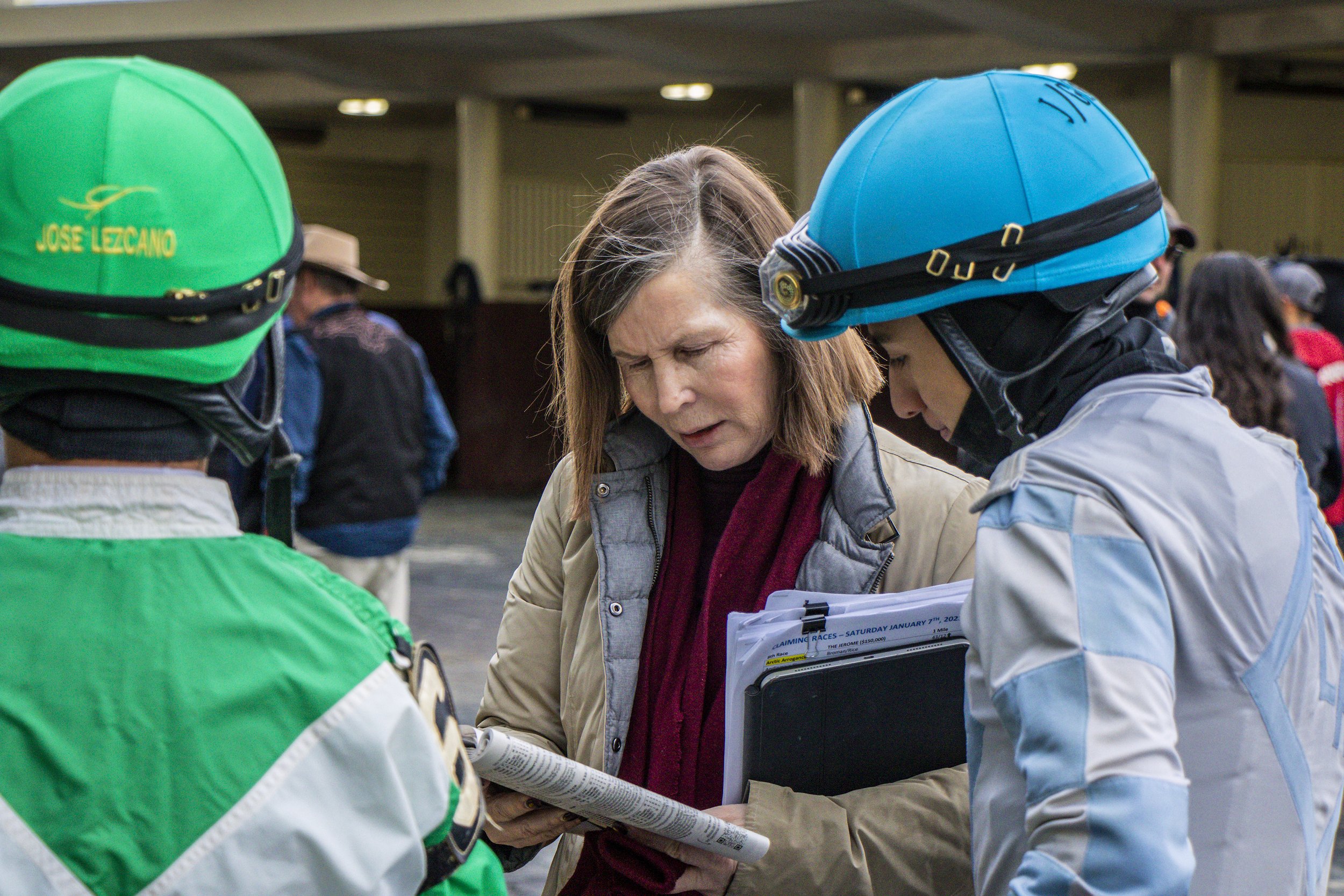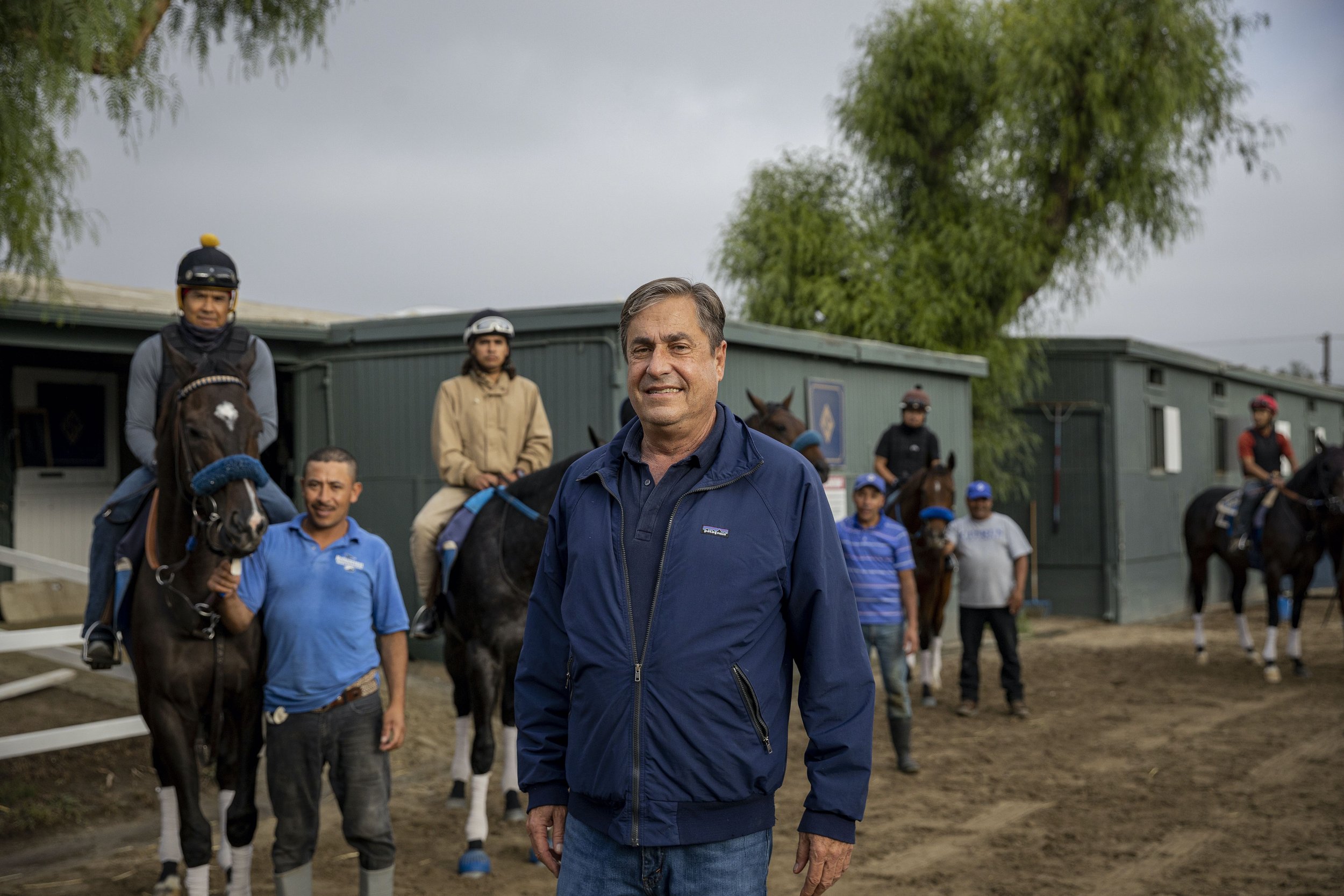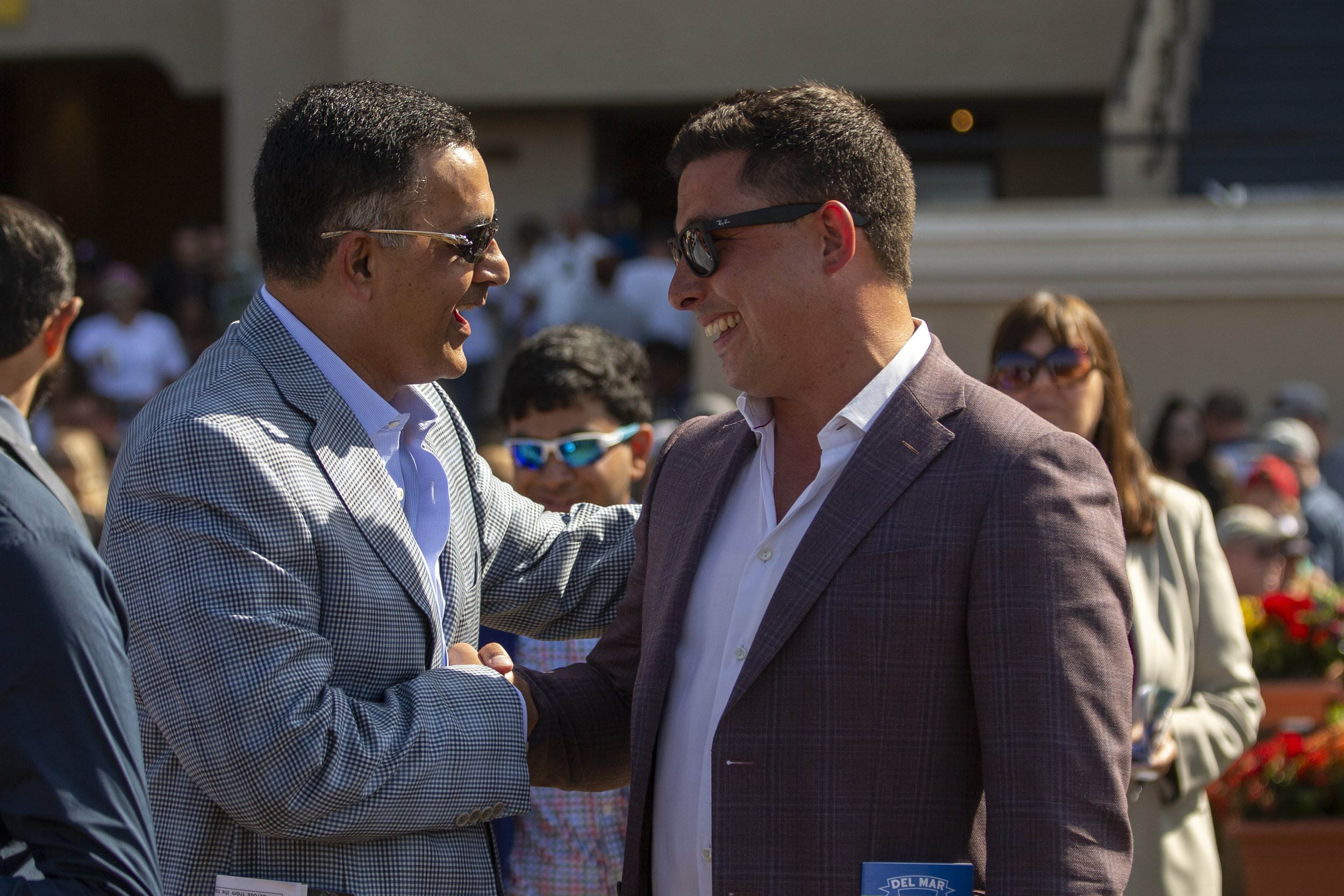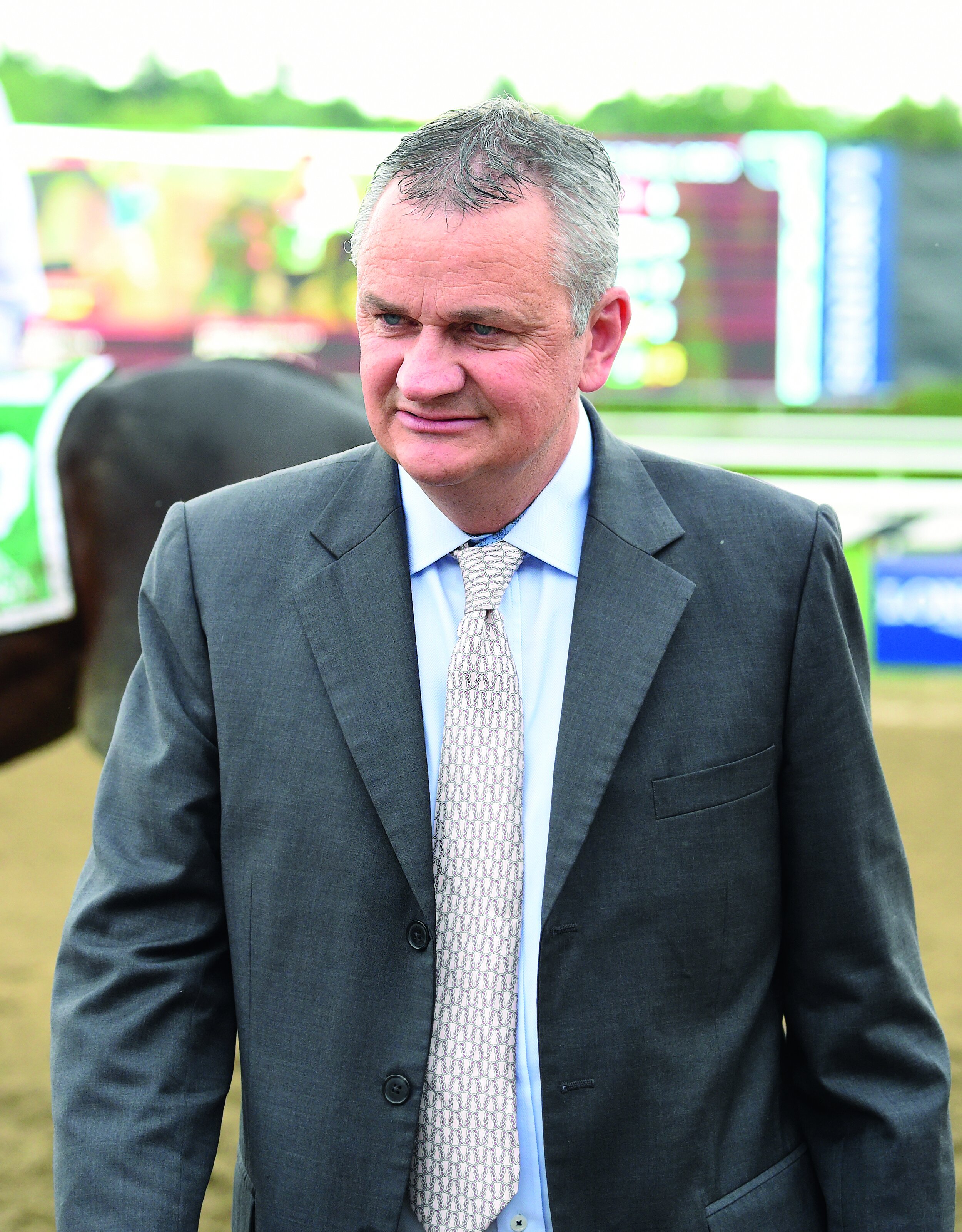#Soundbites - How does the trainer responsibility rule affect you delegating authority to an assistant, exercise rider and/or groom?
By Bill Heller
Linda Rice
You do your best to control as many variables as possible, but, of course, with the trainer responsibility rules and HISA rules, and considering the environment that we are training under at different racetracks and training centers, there are a lot of moving parts. It definitely gives you cause for pause and reasons to worry, but these are the rules that we’ve lived under for a long time, and we do our best and hope everything goes the right way for us.
Jeremiah Englehart
Ultimately, it’s my responsibility. It’s under my name, I’m responsible whether I’m there or not. Communication is always very important in making sure that the people that work on your team understand exactly what you’re saying and what needs to be done and how to do it the right way. Follow the rules. Make sure we’re conforming to the rules that are up there for us. It’s my name on it, but you can’t do everything in the barn. So you have to delegate.
Michael Matz
You just have to be responsible for people’s mistakes when they do make a mistake. That sometimes can be a very difficult situation. Accidents do happen. Sometimes it gets lost in the translation when you’re telling them to do one thing and it just doesn’t get done the way you ask them to do it, whether it’s feeding the horse, whether it’s taking the horse to the races, whether it’s jogging the horse for the veterinarian. This is the hard part. You cannot be lax. You have to make sure that you get it done right. It makes it more difficult, that’s for sure.
Leonard Powell
At the end of the day, the responsibility is one hundred percent ours. You can delegate some, but you can’t delegate 100 percent. So It’s something that we are always aware of. You have to be extremely diligent with the people you’re working with. You have to be on top of it.
Peter Miller
Let me think about it. It depends on the size of your barn. If it’s a small barn, you can do everything yourself, but when you’re running a bigger barn, it’s impossible. So you have to delegate and trust, but at the same time, that can put you at risk. I understand the reasoning for the trainer insurer rule, but it’s unfair in so many instances.
Kelly Breen
I’ve been fortunate enough to have a lot of the same help and they know what the trainer responsibility rule is. In this modern world, you never know what your help is doing. Some of the contamination is eye-opening as to what could be happening to some trainers out there.
Allen Milligan
It just puts me at complete weakness. I try to tell everybody who works for me the same thing: concentrate on what’s going on and make sure something doesn’t happen. But mistakes happen. I’ll never forget at Churchill Downs on Derby Day about 15 years ago, one of the people walking down the backside decided to use one of my stalls for a bathroom. It was a lady in a dress. I caught her coming out of the stall and I said, “There’s a restroom right down there ma’am.” I’ve seen it all.
#Soundbites - What do you look for when you evaluate a yearling at sales, and are there sire lines that influence your opinions?
Linda Rice
Linda Rice
I look for a good shoulder, and usually that will transcend into a great walk, an athletic walk. I do that for the length of stride. I like to buy young mares. Of course I have preference for some stallions I have had success with like City Zip. And then stallions everybody likes: sons of Into Mischief, sons of Curlin, sons of McLain’s Music. I’ve done well with them. If they have a great shoulder and a great walk, I’ll take a shot on an unproven stallion.
Brad Cox
The first thing, from a physical standpoint, is you have to consider his size. Is he too big or too small? As far as sire lines, you’re looking for signs. You totally have to have an idea what the yearling will look like. Will he look like his sire? You pay attention.
Graham Motion
Graham Motion
I think many of us get influenced by stallions’ progeny that we have trained before. There are other ones that we avoid if we haven’t done well with a sire’s prodigy. I think the one thing I look for is athleticism in general. I’m not overly critical of conformation.
John Sadler
John Sadler
We’re looking primarily for dirt pedigrees for California. I have a good idea what works here, what doesn’t work here. Obviously, I’m partial to some of the sires I trained, Twirling Candy, Accelerate, and Catalina Cruiser who’s off to a very fast start. On the conformation side, I look for a well-conformed horse that looks like an athlete. As an experienced trainer, you look for any little things. You learn what you can live with or without. Then, obviously, I’m looking for Flightlines in a couple of years!
Simon Callaghan
Simon Callaghan
Generally, I’m looking for an athlete first and foremost. Conformation and temperament are two major factors. Yes, there are sire lines I like—not one specific one. Certainly it’s a relatively small group.
Tom Albertrani
Tom Albertrani
I’m not a big sales guy, but when I do go, I like to look at the pedigree first. Then I look for the same things as everyone else. Balance is important. I like to see a horse that’s well-balanced, and I like nicely muscle-toned hindquarters.
Michael Matz
One of the things, first of all, is I look at the overall picture and balance. We always pick apart their faults, then what things that are good for them. You look for the balance, then if they’re a young yearling or an older yearling. Those are some of the things I look at. If you like one, you go ahead. There are certain sires if you have had luck with them before. It all depends on what the yearling looks like. I would say the biggest things I look at are their balance and their attitude. When you see them come out and walk, sometimes I like to touch them around the ear to see how they react to that. That shows if they’re an accepting animal.
#Soundbites - The Racing Integrity Act - which will create uniform national medication rules and testing - seemingly on its way to becoming law - is that good or bad?
By Bill Heller
With the Racing Integrity Act, which will create uniform national medication rules and testing, passing the House of Representatives and seemingly on its way to becoming law, is that good or bad?
*************************************
Jimmy Toner
Jimmy Toner
I think it’s good in some respects. We need it. You go from state to state with medication protocol and licenses, and it drives you nuts. We need a national authority to oversee the sport. Same medication rules. Same whip rules. To get that all under one roof will be helpful in that aspect. The other side of the coin is the feds are involved. That might be a bad thing. If it’s an offense, then it's a federal offense.
***********************************
Bruce Brown
I think it’s very good. I am all for uniform rules at every track. It’s a little ridiculous now, always having to know what’s allowed and not allowed with protocols. Not just having a blanket that says this is how it is, this is what you can do, and this is what you can’t. Now, when I ship, I say what can we do here? What’s the difference? So we don’t do something that’s legal in one place and not legal in the other.
**********************************
Pat Kelly
I’m a little skeptical myself. Here in New York, our mid-Atlantic group has been very forward regarding medication standards, trying to get everyone on the same page. We’ve made a lot of progress trying to get the rest of the country to jump aboard with us. I’m not a big fan of big government.
*********************************
Eddie Kenneally
Eddie Kenneally
It’s very good. If it’s passed, the medication guidelines will be the same in every state, and the penalties will be the same in every state, and the testing will be done by the same lab. There are three reasons alone why it’s a good thing. I hope penalties will stick with no loopholes under this new law.
********************************
Linda Rice
Linda Rice
I think there’s a lot to be done on the bill. It’s the beginning of the process and it’s going to take time. But I think it’s a beginning, a start. I think it’s a good thing for racing.
******************************
Tim Hills
I think there is one exception we need. We need to study the Lasix question before we ban Lasix. Everything else, we’re all on board. I think anybody who is not for it has a guilty conscience.
********************************
Mike Stidham
Mike Stidham
I think that we need some uniformity in our industry. Whatever it takes to get that, to get everyone going in the same direction is a move forward. We need something to make this happen. It’s good for racing.
CLICK HERE to return to issue contents
ISSUE 58 (PRINT)
$6.95
ISSUE 58 (DIGITAL)
$3.99
WHY NOT SUBSCRIBE?
DON'T MISS OUT AND SUBSCRIBE TO RECEIVE THE NEXT FOUR ISSUES!
Four issue subscription - ONLY $24.95
#Coronavirus Soundbites
By Bill Heller
We asked trainers how they are handling the coronavirus pandemic and what advice they have for getting through this ordeal
Todd Pletcher
We had to close down our Belmont division. There were workers with symptoms. They went to the clinic and were quarantined. More than anything, it was making it difficult to have a safe workplace. At that time, we thought there wasn’t going to be racing in New York for a while. We had 20 horses at Belmont. That normally would be the time we’d be sending horses to Belmont. We had to put that on hold.
We left it up to owners to decide what to do with their horses. Some went to their farms; a couple went to Fair Hill; some went to Ocala and some went to Palm Beach Downs. We did not move any workers [but] have about 100 horses at Palm Beach, a small string at Gulfstream Park [and] four at Oaklawn scheduled to run. We’ve been fortunate with Gulfstream being able to run. We’ve been able to keep some schedules. It’s juggling a lot of schedules. It’s trying times for everyone. We want to make sure to keep our horses and our employees healthy.
Current practices at Palm Beach?
We’re just going by the recommendations as to what the government is saying. Masks are optional. Some are wearing them; most are not. At Gulfstream, we’re just trying to use common sense, keep people from congregating, keep six feet apart. The one thing we are learning is that social distancing is working. We try to keep that policy in mind.
Planning ahead?
That’s something I have to work around. I’m a target-oriented trainer. I like pointing to specific spots. At Aqueduct, the condition book is in the garbage—Keeneland, too. These are unique times. You have to adjust on a daily basis. Everyone’s in the same boat. Everyone’s facing several challenges.
Suggestions?
Use common sense. Take care of your horses and your staff. In time, we’ll return to normalcy. Try to remain positive.
*******************************************
Eoin Harty
It’s been no harder for me than everybody else. You worry about your family, in California and Europe. Every day you wake up, that’s the first thing on your mind. With horses, you have to take care of them every day. It would be a lot worse for me if we were home 24-7.
Eoin Harty
Precautions?
You can feel that tension in the air. I check every person in the barn; nobody’s coughing. Everyone is wearing gloves and masks—masks for sure around the barn. You don’t have to ask people twice.
Racing?
There’s been a lot of speculation about Santa Anita using Los Alamitos. I don’t know if it’s viable. I think we could be racing at Santa Anita again. The best case scenario is racing at the end of the month or in May. We haven’t had a single case on the racetrack. There hasn’t been a single one. That’s a good thing.
Personally?
I keep six feet away—don’t touch anything.
Suggestions?
Do what you have to do to protect yourself and your family. Right now, it’s common sense. Look out for your friends. Racing will take care of itself.
***************************************
Graham Motion
Graham Motion
My family is all home. My wife is trying to run the business from home. As far as the barn, we’re taking a lot of precautions. We have one person disinfecting everything first thing in the morning and last thing in the evening. He takes everybody’s temperature when they come in the morning. We’re trying to have employees not group up in the tack room. After a week or two, you have to remind them.
Six feet away?
We try to. It’s not totally realistic. You have to give a leg up. Most of the time with gloves. We try to do the best we can.
We’re going to try to get everybody to wear masks. We tried to order some. We have 100 employees all told at all the locations: Fair Hill, Palm Meadows. Normally, we would have pulled out from Palm Meadows for Keeneland, but now we’re staying at Palm Meadows.
Normally I train down there while my son, Chappy, goes to spring break. We got from Fair Hill to North Carolina. We planned to overnight in North Carolina. Once we got there, things were getting bad. We spent two nights in North Carolina, and we decided we’d rather be in Maryland. We went back to Fair Hill. It kind of reminded me of 9-11.
Advice for horsemen?
I think in general, the horsemen are lucky. We get to keep on doing what we do. The horses have to get out of their stalls. I think the unsettling part is not knowing when we’ll race again. We worry about our owners who are paying training fees every day. I’m worried about them. We have 60 horses at Fair Hill and 20 at Palm Meadows. I just brought in a few two-year-olds.
When new people come in, they stay away for two weeks. We’re trying to follow the guidelines.
***************************************
Tom Proctor
I’m in a little better shape than most. Other than Gulfstream and Tampa Bay, I have horses at Oaklawn, and the rest are at Glen Hill Farm south of Ocala. Most of my horses are gathered up at Ocala. We probably got 25 in Ocala and a dozen are at Tampa Bay. I’m spending most of my time in Ocala.
Precautions?
We did have horses at the Fair Grounds. We kept those people from Fair Grounds separate for two weeks. We did get out of New Orleans pretty early—about the middle of March.
Tom Proctor
In Ocala, gloves and masks?
Most of our people don’t leave the farm. We’re not really wearing masks. We’re washing our hands. The zip code we’re in hasn’t had a single case.
When you go to the track, do you take precautions?
I’ve stayed away from people—social distancing when I can. For a trainer, it’s easier than most. I check on the horses when nobody else is around.
**************************************
Tom Amoss
(Tom Amoss was exposed to the virus by being with New Orleans Saints Coach Sean Payton, who contracted the virus, at the Fair Grounds. Amoss self-quarantined for two weeks while continuing to work from home for TVG.)
Did you have the virus?
I never really found out. When it happened, it wasn’t easy to test. I stayed at home for two weeks. Now I’m going to work every day. They really don’t want us up and around in New Orleans. I’m here at my barn every morning from 6-10. My routine is the same.
Protocols at Fair Grounds?
That’s an evolving thing. Our temperature is taken when we come into the track. We’re not allowed in the buildings. Social distancing is a requirement. Fifty percent of the people on the backstretch are wearing masks. We’ve had zero issues in my barn, and none in other barns as well. There’s a reason for that. My help lives on the racetrack. They’re self-contained. There’s a grocery on the backstretch—Canseco’s. We’re the opposite of how New Orleans is doing. We have nothing bad in our barn. I haven’t heard of one case.
Suggestions for other horsemen?
It’s a tough question. Look, there’s a difference between our horses and the horses in California. Our horses are allowed to ship to Oaklawn. No people are shipped. I’ve got a barn up there. I’m blessed in the fact that I already have people there.
Stables?
Ever-changing. There are a lot of horses I have who race on grass. They have been sold or turned out. Other horses who don’t fit the condition and book at Oaklawn have been sold or turned out. We’ve down-sized about 20 percent.
****************************************
Linda Rice
Linda RIce
Handling this?
We’re doing very well. We’re being very careful on Long Island. We know New York City has a lot of cases. We’ve been using masks, gloves and social distancing. We’ve been doing that for three weeks now. We have a regular training schedule at Belmont. It’s good to have a routine. We’re happy to go to work every day. A lot of people are stuck at home. They can’t work. We can.
Response so far?
The help is doing great. Everyone is concerned. We watch the news. It scares the hell out of you. But it’s the old adage: the outside of a horse is good for the inside of a man, or a woman.
What’s going on with racing in New York?
Aqueduct, obviously, is being used as a hospital. I think everyone here is under the impression that we’ll be racing at Belmont. It’s just a matter of when. We’re looking at June 1st. If it’s sooner than that, great.
Outlook?
The entire world is dealing with this. If there is small business assistance, that’s great if it can get processed. Unemployment for those out of work will help. We’re making sure of helping everyone on the backstretch who needs it. We’re making sure our horses and our people are safe.
Voodoo Song wins many races
By Bill Heller
Once upon a time, Thoroughbreds raced on little rest: on consecutive days, twice in three days, three times in eight days. Those days are long gone, but every now and then one Thoroughbred reminds us that it can be done; that while such quick-recovering horses may be an endangered species, they are not yet extinct. Of course, it only happens if a horse’s trainer believes that particular Thoroughbred can do so and can live with the result, positive or negative, for thinking outside the box.
Last summer at Saratoga, trainer Linda Rice sent out Barry Schwartz’s three-year-old colt Voodoo Song to compete in a mile-and-three-eighth New York-bred grass allowance four days after he won an open mile-and-a-sixteenth $40,000 claimer by 5¼ lengths gate-to-wire. Voodoo Song, who had been with Mike Hushion until the trainer’s retirement in July, opened a 16-length lead in that allowance and held on to win by three-quarters of a length.
“If you’re afraid to take chances or afraid to be wrong, you’re going to be paralyzed,” Rice said. “Some people are too afraid to make mistakes or be proven wrong. If it doesn’t work, it doesn’t work.”
Boy did it work with Voodoo Song. “The more latitude the owner gives you, the better,” she said. “Barry was fine with the direction we took. If the horse is doing well, run him.”
According to the Daily Racing Form, Voodoo Song’s victory made Rice seven-for-her-last-eight starts with a horse returning within seven days.
But Rice wasn’t done with Voodoo Song at Saratoga. With ample time to recover from the two races, Voodoo Song won another mile-and-a-sixteenth New York-bred allowance by one length four weeks later. Nine days after that, the colt made his stakes debut in the $300,000 Grade 3 Saranac, and he won again on the front end, by a neck over a field which included previously undefeated Bricks and Mortar. Those four victories in a single Saratoga meet, all under Jose Lezcano, matched Native Dancer’s four-race Saratoga spree in 1952 when the meet, now 40 days long, was just 24. All four of Native Dancer’s victories were in stakes.
To match the feat of four Saratoga wins is nothing short of amazing in 2017 because Thoroughbreds have never seemed more fragile.
According to The Jockey Club, average number of starts per Thoroughbred has plummeted from 11.5 in 1960 to 9.8 in 1975 when the diuretic Lasix and analgesic butazolidin first began showing up on backsides of racetracks. By 1990, the average number of starts was 9.0. It dropped to 6.8 in 2005 and 6.2 in 2016. Accordingly, average field size was 9.0 in 1960, 8.6 in 1975, 8.0 in 1990 and in 2005 and 7.6 in 2016.
Go further back in time and Thoroughbred racing was a different universe. Trainers raced and worked healthy horses constantly, even when they were two-year-olds. And they kept racing for years.
Imp (during the 1896 season), Princess Doreen (1923), and Zev (1924) ran on consecutive days. Imp finished first and third, Princess Doreen was first twice, and Zev won twice. Zev won his following start on one day’s rest, completing three victories in four days. Later in her career, Imp raced six times in 15 days, posting three wins, two seconds, and a fourth.
More famously, Maskette (1908) won her career debut in an allowance race against males and then the Spinaway Stakes two days later.
In 1918, a year before he became the first horse to win the races that later came to be recognized as the Triple Crown, Sir Barton began his career with a fifth, a ninth, another ninth on one day’s rest, and a seventh, all in stakes.
Man o’ War (1919) won two stakes in three days.
Seabiscuit began his career on January 19th, 1935, finishing fourth in an allowance race at Hialeah. Just three days later, he finished second in a $2,500 claimer. Did returning quickly affect his career? Not even close. Seabiscuit made three more starts with two days of rest and then raced on one day’s rest, finishing sixth in a stakes and third in an allowance race at Aqueduct Sept. 2nd and 4th. He went on to make 35 starts as a two-year-old, posting five wins, seven seconds, and five thirds. He would make 54 more starts and achieve stardom.
TO READ MORE --
BUY THIS ISSUE IN PRINT OR DOWNLOAD -
August - October 2018, issue 49 (PRINT)
$5.95
August - October 2018, issue 49 (DOWNLOAD)
$3.99
Why not subscribe?
Don't miss out and subscribe to receive the next four issues!
Print & Online Subscription
$24.95
Linda Rice - a racehorse trainer making her mark on the big stage
If you win the training title at Saratoga, people will notice you. Linda Rice, catapulted into national recognition when she became the first woman to achieve this coveted honor in 2009, has been turning the heads of those in the know for many years now.
By Kathleen Donovan
FIrst Published (21 July 2010 - Issue Number: 17)


























